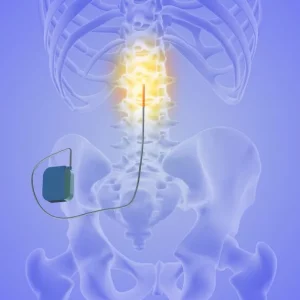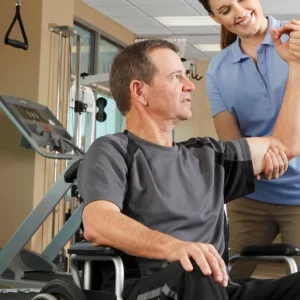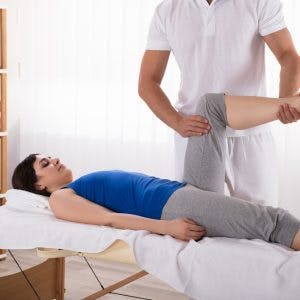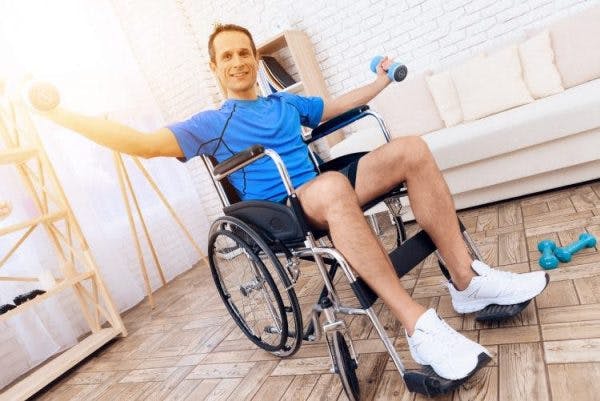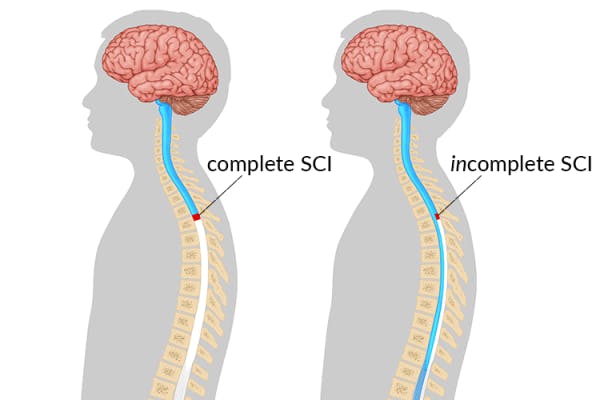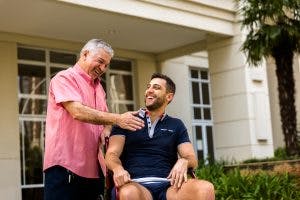Following a spinal cord injury, leg swelling is a common complication that can impact daily life and overall function. This swelling, known as ‘edema,’ is caused by the buildup of fluids in the body and can occur suddenly at any stage following spinal cord injury.
Depending on the level of spinal cord injury, many individuals experience paralysis of the legs, which limits mobility and contributes to swelling. When the legs are less mobile and are in a dependent (low) position, such as in a wheelchair, gravity pulls fluids downward, leading to dependent edema. This is characterized by fluids pooling in the legs since they are not being pumped back upward by the weak or paralyzed muscles.
Fortunately, there are several ways to reduce edema and decrease risk of additional complications. In this article we will discuss 8 effective ways to help reduce and manage leg swelling after spinal cord injury.
How to Reduce Leg Swelling After Spinal Cord Injury
Spinal cord injury can affect many functions below the level of injury. Since the leg muscles are innervated by the lower segments of the spinal cord, all spinal cord injury patients experience some degree of weakness or paralysis in the legs.
Regular leg movements are necessary to promote blood flow back to the heart. When movement is limited due to spinal cord injury, blood may begin to pool in the legs and cause them to appear swollen, red, and shiny. Dependent edema can increase risk of blood clots and can also cause the skin to become more fragile and prone to sores.
To decrease risk of complications, it is important to monitor swelling and take steps to reduce edema. To help with this, here are 8 tips for treating swelling in the legs after spinal cord injury:
1. Move Often
As we’ve discussed previously, blood and other fluids can begin to pool in the legs when they are not moved enough. This means frequent movement is very important to help reduce or prevent swelling.
When your mobility is limited, passive range of motion exercises can be used to promote movement without requiring active muscle function in the legs. This means you can use non-affected muscles to help move the affected ones, with or without the use of a band or other assistive device.
If your upper extremities are affected or very weak because of spinal cord injury, ask your caregiver, physical therapist, or nurse to help you move your legs. Your therapist may also be able to provide you with some techniques to help you perform passive leg movements independently.
Moving the legs using passive range of motion exercises promotes circulation and can lessen joint stiffness. This in turn can help move fluid back out of the legs to reduce edema. To help get you started, we’ve provided a link for passive range of motion exercises for spinal cord injury patients.
Want 15 pages of SCI recovery exercises in PDF form? Click here to download our free SCI Rehab Exercise ebook now (link opens a pop up for uninterrupted reading)
2. Limit Sodium Consumption
Eating excess sodium can contribute to dehydration, causing the body to hold onto fluids. This can lead to increased swelling, specifically in the feet, ankles, and legs. Since sodium can cause fluid retention, limiting your sodium intake may be a helpful strategy to reduce leg swelling after spinal cord injury.
Instead, try to consume more fresh or frozen fruits and vegetables. These foods have a high water content and are naturally low in sodium. It’s also important to monitor sodium amounts on packaged foods and to try to find foods labeled as “reduced sodium” or “no salt” added, according to the CDC.
3. Elevate Your Legs
Just like gravity pulls excess fluids to the legs, elevating your legs can allow gravity to direct fluid back to the heart. Even just 15 minutes of leg elevation can help reduce leg swelling after spinal cord injury and can be performed several times per day.
Stack a few pillows on top of each other and elevate your legs on them while you you’re laying down. It’s a good idea to have your heels hanging off the edge of the pillows to minimize the risk of pressure sores developing on your heels.
4. Drink More Water
Swelling is caused by excess fluid in the body, so it might seem contradictory to drink more water. However, dehydration can cause the body to hold onto fluid because it doesn’t know when you’re going to replenish its supply.
To avoid increased fluid retention, make sure you’re drinking enough water throughout the day so that your body doesn’t feel the need to store it for later. This can also help regulate sodium levels, further decreasing leg swelling after spinal cord injury.
5. Wear Compression Stockings
Wearing compression stockings or socks adds pressure to the legs to increase blood pressure and help to move excess fluid. This is especially true for gradient compression stockings, which have the highest compression at the foot and gradually loosen as they go up the leg, pushing fluid in the right direction.
Although low blood pressure is more common in patients with spinal cord injury than high blood pressure, it is a good idea to talk to your doctor to see if compression stockings are safe for you and your particular medical history. Your physical or occupational therapist can also help you choose compression stockings that are appropriate for your needs.
When choosing compression stockings, make sure the stockings are not too loose or too tight to ensure their effectiveness and avoid complications. Also, make sure there are no big wrinkles once the compression stockings are on. This can act as a tourniquet on your leg, making swelling worse in a particular area and putting you at risk for developing a sore or autonomic dysreflexia.
6. Massage Your Legs
Massaging your legs can help stimulate blood flow and reduce swelling. Similar to compression stockings, the additional pressure created by massage can improve circulation and helps to move the extra fluid out of your legs. This can also help with pain relief and can increase flexibility, potentially improving performance of daily activities and transfers.
To get started, try massaging your legs in an upward motion, starting at your feet and moving towards your trunk. This helps to redirect pooled fluids out of the legs and back to the heart. Additionally, it may be helpful to immediately put on compression stockings after massage to help maintain any reduction in swelling you were able to achieve.
7. Avoid Hot Temperatures
Warm temperatures can cause your blood vessels to expand (vasodilation) so that heat in your blood can get closer to the surface of the skin and evaporate to cool you off. This vasodilation creates increased fluid, which can become trapped in the legs and lead to leg swelling after spinal cord injury.
Staying cool can help promote narrowing of the blood vessels (vasoconstriction) to reduce leg swelling. Although the temperature of your environment may be out of your control, there are several ways to help stay cool and reduce leg swelling after spinal cord injury.
Some actions you can take to avoid vasodilation include:
- Staying out of direct sunlight
- Wearing light, easy-to-remove layers
- Carrying a spray bottle of water or a damp towel
- Staying hydrated
8. Get Cardiovascular Exercise
Engaging in regular cardiovascular exercise is vital to help maintain good circulation and heart health. Any movement that increases heart rate can help promote circulation throughout the body and assist with moving fluid out of the legs, decreasing leg swelling. Cardiovascular exercise can also help with flexibility, stress, cholesterol, and sleep.
Following a spinal cord injury, it may feel difficult to perform cardiovascular exercise due to decreased mobility. However, there are many ways that individuals can engage in cardio after spinal cord injury.
Different examples of cardiovascular exercise after spinal cord injury include:
- Propelling your wheelchair briskly
- Hand cycling
- Using exercise bands
- Sitting aerobics or circuit training
Talk with your physical therapist to help create an exercise plan that is appropriate for you. Additionally, it is important to keep SCI exercise guidelines in mind to avoid risk of overexertion or autonomic dysreflexia. This includes increasing exercise intensity gradually and taking sufficient rest breaks.
Inspect Your Body Regularly After Spinal Cord Injury
Since spinal cord injuries often cause impaired sensation, many SCI patients don’t notice when they are injured or their skin is irritated. Daily body inspections can help identify spinal cord injuries such as heterotopic ossification and deep vein thrombosis, which can both contribute to leg swelling.
Heterotopic ossification is when abnormal bone growth occurs in soft tissue below your level of injury. This is caused by miscommunication between the brain and body after spinal cord injury, signaling bone cells to form bone in inappropriate locations, such as within the muscles. This abnormal growth can cause swelling in the legs.
Deep vein thrombosis is when a blood clot forms due to pooling blood or physical inactivity, generally occurring in only one leg. The clot can cause leg swelling and limit blood flow back to the heart.
Frequent body inspections will help identify complications early and allow you to manage them before they progress. If you do notice signs of a deep vein thrombosis, such as single leg swelling or redness, seek medical attention immediately as this can be dangerous and life-threatening.
Understanding Spinal Cord Injury & Leg Swelling
Swelling in the legs after spinal cord injury can be caused by a combination of factors including dependent positioning, dehydration, sodium levels, and physical inactivity.
This leg swelling, or edema, can lead to complications such as skin breakdown and deep vein thrombosis. Therefore, it’s essential to manage leg swelling in order to maximize circulation and avoid complications. This can include passive movement, compression stockings, massage, elevation, and cardiovascular exercise.
We hope this article has been a helpful resource for managing leg swelling after spinal cord injury. Now that you know what actions you can take to reduce swelling, we hope you try them out for yourself!

